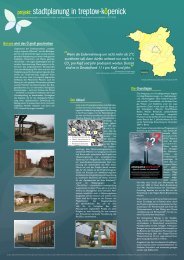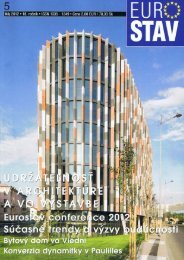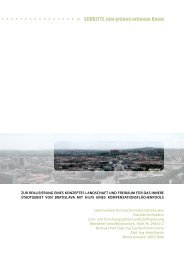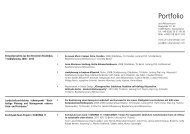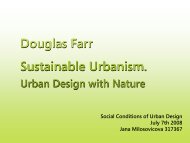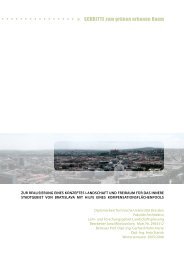Thesis document - Jana Milosovicova - Urban Design English
Thesis document - Jana Milosovicova - Urban Design English
Thesis document - Jana Milosovicova - Urban Design English
- No tags were found...
You also want an ePaper? Increase the reach of your titles
YUMPU automatically turns print PDFs into web optimized ePapers that Google loves.
3 Climate-Sensitive <strong>Urban</strong> <strong>Design</strong>(CSUD) in moderate climate zone“Poor urban design is the biggest cause of the heat islands in our cities”(Larry West in EnvironmentAbout, online).We therefore need to reinforce the thoroughly understood way of Climate-Sensitive<strong>Urban</strong> <strong>Design</strong> (CSUD) – a comprehensive way of designingour cities while skilfully combining all possible means.As demonstrated in the section 2, significant research has been doneon urban climate and on effects of the urban heat island and on howthese can be mitigated. Thus, when addressing the UHI mitigation incities, these findings are of considerable importance. According to thefindings, a combination of measures in the below mentioned areas ofintervention should be applied in urban design 32 :• <strong>Urban</strong> form – in particular, density/compactness and geometry– That allows proper rate of insolation/shading, ventilation andallowing space for vegetation;• Natural ventilation – Taking advantage of existing and creatingnew ventilation channels; creating air-permeable buildings andbuilding complexes (the latter with the help of urban geometryadjustments), for balancing-out the “urban” heat with provision ofcool air;• Solar radiation – Transforming the incoming solar radiation intolatent heat with the help of water and vegetation; shade provision;application of high albedo materials to prevent heating up ofsurfaces (as a measure of secondary priority);• Natural water cycle – Total reduction of rainwater run-off throughintroducing decentralized rainwater management whose primaryfocus is on rainwater evaporation on site by creating water permeable,preferably vegetated surfaces as well as by enhancing thepresence of water bodies;• Vegetation – Enhanced greening of cities, in particular greening ofbuildings and extensively used man-made surfaces to enhance theevapotranspiration rates.As such, Climate-Sensitive <strong>Urban</strong> <strong>Design</strong> aims at the combination ofvarious elements that mitigate the UHI effects. The design is to involvestreet profiles, building orientations and appropriate urban densityand compactness, which provide adequate geometry for shadingand natural ventilation of streetscapes and buildings and thus alleviatethe anthropogenic heat loads. The urban form arrangements are to becombined with the decentralized overground rainwater management,water bodies, green roofs, podium gardens, balcony/terrace gardens,façade greenery, street plantings (trees and vegetated swales), fore-32 For the purpose of this <strong>Thesis</strong>, the design of the buildings (which, for example,influences the requirements for heating and air-conditioning) will be avoidedin detailed considerations. The <strong>Thesis</strong> focuses on the beyond-a-single-buildingreachingurban design level, and on landscaping features.36Climate Sensitive <strong>Urban</strong> <strong>Design</strong> in Moderate Climate Zone: Responding to Future Heat Waves. Case Study Berlin Heidestrasse/Europacity



